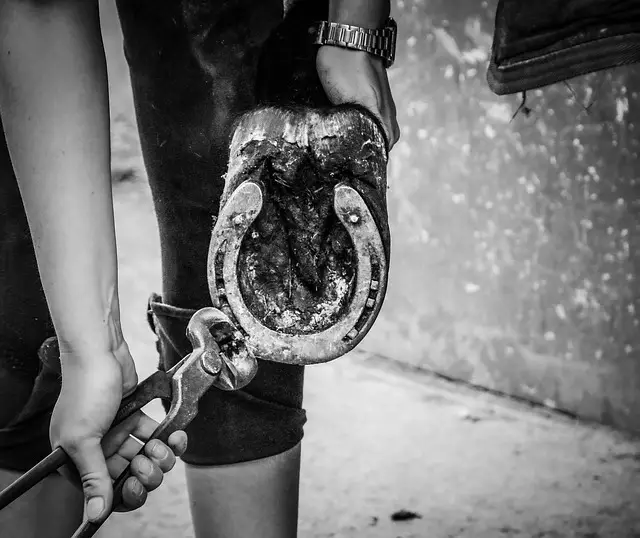Last Updated on March 26, 2022 by Allison Price
Two diseases are commonly associated with a horse’s frog. The most common is Thrush, which is a bacterial disease that affects the horse’s hoof, in particular the area of the frog. The bacteria can be found naturally in an animal’s environment, especially if it is wet, muddy or otherwise unsanitary, such as a dirty stall.
Canker is less common and more difficult to treat. Although it looks very similar to thrush at first, canker can become very frustrating and difficult for all involved if it is not treated properly.
What is Canker in Horses?
Horse canker is an infectious disease that causes chronic hypertrophy (i.e. enlargement or growth) of the horn-producing tissues in the horse’s hoof. If left untreated, the disease can spread to the sole, bars and wall of the hoof. This is most common in draft horses, but can also occur in other breeds of horses. It can affect one or more feet at once, but the hindlimbs are affected more often.

Although canker was originally thought to be caused by poor hygiene and/or wet conditions similar to thrush it is now seen in horses who are well-cared for and receive regular hoof care. It is unknown what causes canker, although anaerobic bacteria was initially thought to be a stimulus. Recent research has shown that bovine-papillomavirus was present in horses with canker lesions. There are many factors that may play a role in the pathogenesis of canker lesions on horses.
Anatomy of the Normal Hoof – Life Data Labs, Inc., http://www.lifedatalabs.com/articles/hoof-anatomy
What are the Signs of Canker Disease?
Canker is often mistaken for thrush. Thrush causes tissue loss and spreads to the heels, bars and hoof wall. In its early stages, canker may appear as a central area of granulation tissue that bleeds easily when it is abraded.
Canker in its earliest stages. Virginia Therapeutic Farriery – How to Treat Equine Caker. Stephen E. O’Grady BVSc,MRCVS & John B. Madison, VMD, DACVS. 2004 AAEP Convention Proceedings
The disease can spread to the hoof wall, sole, bars, sole and sole if it is not treated. The symptoms of the infection are small, finger-like, off white projections that look like cauliflower. The infection stimulates abnormal keratin formation (dyskeratosis). The infection can also be associated with an unpleasant odor. It can also be covered by white fluid that looks like cottage cheese. The infection will usually spread beneath the horny part of the frog. The horse will feel pain in the affected foot and may appear limp.
Advanced canker. Virginia Therapeutic Farriery – How to Treat Equine Cancer. Stephen E. O’Grady BVSc,MRCVS & John B. Madison, VMD, DACVS. 2004 AAEP Convention Proceedings
How is canker diagnosed?
The epidermis layers of the frog are often home to anaerobic bacteria.
Canker severe in an old draft horse. American Farriers Journal: Treating Prolific Candker. Lisa Giza
How is canker treated?
Although Therapy can be difficult, it is possible to achieve success with therapy.
1. It is crucial to remove all abnormal tissue and restore the normal corium. You can either stand while receiving regional anesthesia for the limb or general anesthesia. The complete destruction of diseased tissue can be achieved by electrocautery, cryotherapy or excision. It is important to not remove excess corium as it can slow down the cornification process and cause the sole to become less durable.
Debriding the affected tissues. American Farriers Journal: Treating Prolific Candker. Lisa Giza
2 The area to be treated must remain dry and clean. This can be accomplished with dry bandaging.
3. Topical treatment that has been most effective in treating canker include daily cleanings, followed by the application of 10% benzoylperoxide in Acetone c and then packing the area with crushed metronidazole tablet. Daily cleaning removes surface bacteria. Acetone and benzoyl peroxide keep the tissue dry. The metronidazole kills anerobic bacteria.
Bandaging and treating the foot. American Farriers Journal: Treating Prolific Candker. Lisa Giza
The canker prognosis should be guarded. However, owner compliance is crucial to the successful treatment. Some cases heal in a matter of days to a few weeks, while others take months to heal. The disease is rarely recurred once the tissue has healed. Canker can often return if the treatment is stopped before the tissue heals. This frustrates both the owner and the veterinarian.
Canker-free feet. American Farriers Journal: Treating Prolific Candker. Lisa Giza
Do you have any hoof care questions for Badger Equine veterinarians Leave a comment and we’ll answer your question!


